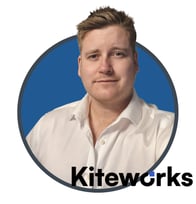What does Managed File Transfer (MFT) look like in 2024? We asked our Pro2col experts and industry leaders to get out their crystal balls and share their predictions for MFT this year...

- A Decade of Managed File Transfer and the Impending Security Imperative
- Introduction of Artificial Intelligence to File Transfer
- Importance of Managed File Security
- A Big Push Towards more Secure Platforms
- Forward Thinking but Backward Compatible
- Ensuring Security is our Paramount Concern
- The future of Managed File Transfer is still Bright
A Decade of Managed File Transfer and the Impending Security Imperative
"I’ve been analysing the Managed File Transfer marketplace for more than a decade now and some of the predictions of the past still ring true today. A few of the larger vendors in this space continue to fail to keep pace with the more innovative front runners due to the lack of investment in development, resulting in enterprise process redesign condemning them to the ‘legacy software’ bin. Stepping into the void are some of the perceived ‘smaller vendors’ that are making great progress in functional capability, willingness to listen and ability to make changes quickly. I think we’ll see a continued shift from some of the behemoth vendors to the nimbler and more responsive, to address changing integration patterns, upsetting the status quo like never before, regardless of the migration challenges.
This past year has seen massive data breaches globally, targeting some of the most recognised solutions in our industry. The result being that Managed File Transfer solutions are under increasingly, intense scrutiny. However, ensuring your own security is not enough. I’m 100% convinced this will refocus enterprises to pay greater attention to the security of their supply chain, evaluating and monitoring the software and systems will determine supplier choices, or drive positive change.
Introduction of Artificial Intelligence (AI) to File Transfer
Chris has been working in IT Security and MFT for over 15 years. Having been the lead consultant at Infinigate and founder of Advanced Cyber Solutions, Chris has been a specialist in selling, marketing and delivering File Transfer Solutions for much of his career. Follow Chris on LinkedIn.
"Predictive conversations and discussions on the application of AI into all manner of IT related tasks is commonplace at the moment; and our industry is no different. Although the introduction of AI into file transfer, workflow automation and document collaboration hasn’t really started, it is starting to creep into vendor roadmaps and will gather pace in 2024. Being a specialised market, which has a skills shortage, it is primed for the type of disruptive efficiency that AI can introduce.
There are a number of areas which we believe that AI – including machine learning and deep learning – will have an impact on. At a basic level, we expect reporting modules and tools to provide better insight into data gathered from solutions over time. For example, being able to optimise a schedule of automated workflows for better resource usage or network conditions, which could speed up the transfer of data or improve its successful deliverability rate. On a more advanced level – and maybe more of a 2025 prediction - I expect solution vendors to tap into their wider portfolios and partnerships; and start to explore how they can dynamically adapt the movement of data and files based on conditions which are typically external its consideration.
Wouldn’t it be cool if file transfer solutions could prioritise the delivery of data based whether it is an order, the value of the order and how profitable it was - dynamically selecting an optimal route and format for delivery to a third-party, which if haven’t communicated with before, it can negotiate and setup itself? Put your feet up and watch it do all the work!"
Importance of Managed File Transfer Security
"Security has long been a focus of Managed File Transfer solutions, but recent events continue to spotlight the critical importance of MFT security. Simply “ticking the box” on a marketing sheet will be insufficient for MFT customers in the coming year, and vendors will need to show that best-practice security is central to their core values. Customers will require transparency, rapid resolution of vulnerability reports, and a vendor commitment to continuously adopt the latest security standards.
In 2024, MFT vendors will be prioritising security enhancements and access controls above other new features, as customers will demand this. There will be a focus evaluating source code for potential security weaknesses. Designing and implementing security features will have an eye toward a complete and comprehensive approach that reduces the risk of data breaches."
A Big Push Towards more Secure Platforms
With 18 years of experience in Cyber Security, Ben looks after Global, Strategic and Regional accounts for the UK&I and Netherlands regions, playing a major role in technical engagement, helping customers share all kinds of sensitive missions critical content easily, effectively and securely. Ben is vital in the development and support of their partner community and prides himself on helping protect organisations from cyber threats with his customer-centric mentality. Follow Ben on LinkedIn.
Ensuring Security is our Paramount Concern
"Ensuring security is our paramount concern, especially in the current landscape. Fortra stands uniquely positioned, boasting a range of cybersecurity products that we are actively integrating to enhance the protective measures for our customers. Our integration with Fortra’s Clearswift ICAP Gateway application ensures seamless malware scanning for all incoming files. We strongly advise customers to augment their security posture by incorporating a web application firewall (WAF). Using Fortra's WAF provides unified support from a single vendor.
An exciting development on our horizon is the Fortra Threat Brain. This innovative system consolidates data from our diverse cybersecurity products into a centralised database, cataloguing potential risks. These Fortra products, including GoAnywhere, can then retrieve the updated data. Leveraging this database, we’re looking into having GoAnywhere autonomously block access from malicious IPs and pre-emptively preventing the reception of files and emails from these sources. Our commitment to security remains unwavering as we pioneer solutions for a safer digital environment."
The Future of Managed File Transfer is still Bright
"If there was a silver lining to the dark cloud that seemed to hover over MFT in 2023, it is that many organisations took the time to examine their MFT—and other software product—deployments, their digital supply chains, and their standard operating procedures where data movement and management is involved. That is why we declare that the future of managed file transfer is still bright.
We’ve been having many conversations, sparked by those unfortunate events, with organisations looking for alternatives to their incumbent vendors or to displace their home-grown processes. We’ve talked with customers who are moving to standardise on our secure-by-design Diplomat MFT managed file transfer solution and mandate that their customers adopt our platform or a compatible secure MFT solution before they will allow them to transfer files to or from their own systems.
We also know that the future of managed file transfer is bright because it is a trusted and mature technology, and with continuing emphasis on data privacy and security, MFT only makes sense." Continue reading more about Coviant's 2024 predictions here.







